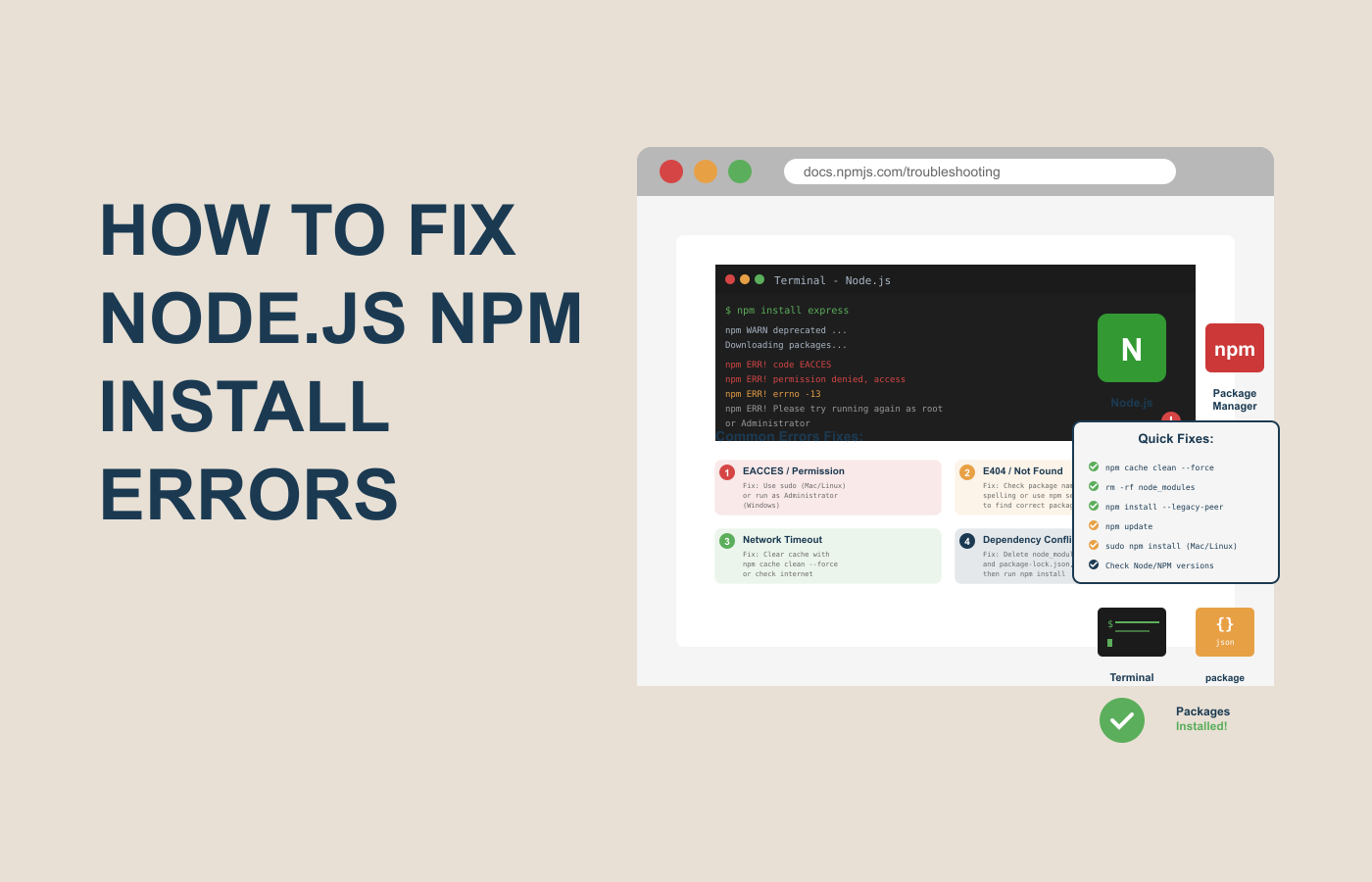How to Fix Node.js NPM install errors

Why npm install errors Are Frustrating and Important to Solve
If you’ve ever run npm install and got bombarded with red error messages, you’re not alone. NPM (Node Package Manager) is essential for building Node.js apps, but it’s often the source of frustration when things go wrong.
Whether you’re a beginner or an experienced developer, npm install errors stop development in its tracks. You can’t install dependencies, build your project, or even move forward.
The good news? Most npm install errors are solvable by following a few systematic steps. In this guide, you’ll learn:
What common NPM issues look like
Why they happen
Step-by-step solutions you can try right away
Alternatives and tips to avoid them in the future
Let’s get your Node.js setup back on track.
Common Causes of npm install errors
Understanding why NPM fails helps you pick the right fix. Here are the most common causes:
Permission or access errors (EACCES, EPERM)
Corrupted cache or broken npm installation
Dependency conflicts or peer dependency issues
Missing system tools or build dependencies (node-gyp, C++ build tools)
Network / SSL / registry issues
Invalid JSON in package.json or missing files
File locks or resources busy (EBUSY) on Windows
No space on disk or write permission issues
The official NPM docs also list many of these under “Common errors” such as permissions errors, cache problems, broken installs, invalid JSON, SSL errors, etc. refer npm Docs
Now, let’s walk through concrete solutions.
Step-by-Step Fixes & Solutions
Below are structured steps to diagnose and fix most npm install errors. Try them in order—from least invasive to more drastic—so you don’t lose your work.
Step 1 — Verify Node.js and NPM Versions
Sometimes your NPM error is simply because you’re using an incompatible version or outdated tools.
node --version
npm --version
If your versions are old or mismatched, update Node.js (which often includes a newer NPM) or update NPM globally:
npm install -g npm@latest
Step 2 — Clear NPM Cache
A corrupted cache is a very frequent culprit. NPM’s documentation recommends:
npm cache clean --force
Then try your install again. refer npm Docs
This often solves weird, random errors.
Step 3 — Fix Permission / Access Errors (EACCES / EPERM)
If you see errors like EACCES permission denied or EPERM, especially on global installs, here’s what to do:
On Linux/macOS:
Use a Node version manager (likenvm) so global installs don’t require root.If you must install globally, avoid using
sudo npm installrecklessly. Instead, change directory ownership:sudo chown -R $(whoami) /usr/local/lib/node_modules
On Windows: ensure your user has write permission to the folders, or run the terminal as Administrator.
Step 4 — Delete node_modules and Reinstall
If a project’s dependencies get messed up, a clean slate often helps:
rm -rf node_modules
rm package-lock.json # or yarn.lock, if using yarn
npm install
This ensures dependencies are freshly resolved. If dependencies conflict, you may need to use --legacy-peer-deps or --force flags.
Step 5 — Handle Dependency Conflicts / Peer Dependency Errors
Modern NPM versions enforce stricter rules for dependencies. You might see:
npm ERR! ERESOLVE unable to resolve dependency tree
When that happens:
Try:
npm install --legacy-peer-deps
or
npm install --force
Inspect
package.jsonfor conflicting versions and manually adjust them.
Using those flags helps bypass strict resolution rules.
Step 6 — Ensure Required Build Tools Are Installed
Many packages (especially those with native bindings) need compile tools (node-gyp, Python, C++ build tools, etc.). If installation errors mention gyp or compilation failures:
On macOS:
xcode-select --install
On Linux (Ubuntu/Debian):
sudo apt-get install build-essential python3
On Windows:
Install “Build Tools for Visual Studio” and ensure Python is installed.
Also check the relevant GitHub issue threads for node-gyp errors. refer GitHub+1
Step 7 — Address File Lock / EBUSY / Resource Busy Errors (Windows)
On Windows, you might see errors like EBUSY or resource busy when files are locked or in use. Common fixes:
Close all open editors, terminals, or file explorers pointing into your project folder.
Kill processes holding file handles.
Reboot your machine if necessary.
For example, in StackOverflow a user solved EBUSY by closing the editor and clearing the folder before retrying. refer Stack Overflow
Step 8 — Check Disk Space or Write Path Issues
If your drive is full or the temp folder is unwritable:
Free disk space or relocate
npmtemporary directory:npm config set tmp /path/to/large/drive/tmp
Ensure your directories are writable.
NPM’s documentation notes ENOSPC (no space) and path permission issues are common errors. refer npm Docs
Step 9 — Use Verbose or Debug Mode
If errors remain opaque, run:
npm install --verbose
This shows detailed logs, including exactly where dependency or file operations fail. The extra insight can pinpoint the root issue.
Step 10 — Reinstall or Repair NPM / Node Installation
When you’ve tried everything but NPM still misbehaves, reinstalling can fix broken installations:
On macOS/Linux: use the official Node.js installer or a version manager (
nvm)On Windows: uninstall Node.js fully, delete global npm folders (
AppData\Roaming\npm, etc.), then reinstall freshAfter reinstalling, run
npm doctorto spot issues
Comparison Table: Fix Methods vs. Scenario
| Scenario / Symptoms | Use This Method | Notes |
|---|---|---|
| Random install failures | Clear cache | npm cache clean --force |
| Permission denied on global install | Fix permissions, use nvm | Avoid sudo npm install |
| Dependency tree errors | --legacy-peer-deps or --force | Use cautiously |
Build failures / gyp errors | Install build tools | Node-gyp needs compilers |
| Locked files / EBUSY errors | Close processes or reboot | Common on Windows |
| No space or temp folder issues | Change npm tmp or free up disk | Disk write is essential |
| Ongoing mystery errors | Reinstall Node/NPM | Fresh setup clears corruption |
Extra Tips & Alternative Tools
Use Yarn or pnpm as alternative package managers. They sometimes handle dependency resolution more gracefully
Use nvm (Node Version Manager) so you can easily switch Node versions and avoid version mismatches
Use npm-check-updates (ncu) to automatically upgrade dependencies to compatible versions
Use Docker or containerization to isolate environment issues
Regularly run
npm auditto find vulnerabilities in dependencies
Frequently Asked Questions (FAQs)
Q1: Why does npm install fail in a directory without package.json?
Because npm expects that file. Make sure you run commands in a project folder containing package.json.
Q2: What does EACCES or EPERM mean in NPM errors?
They are permission errors, meaning your user account doesn’t have rights to install or write to the directory.
Q3: When should I use --legacy-peer-deps?
Use it when NPM throws peer dependency resolution errors (e.g. ERESOLVE) in newer Node versions. It relaxes strict dependency enforcement.
Q4: Why is node-gyp failing on npm install?
Because build tools aren’t installed (Python, C++ compiler, etc.). You must install system dependencies matching your OS.
Q5: How to fix EBUSY or “resource busy” on Windows?
Close all editors or processes accessing the folder. Delete node_modules, reboot, and re-run install.
Conclusion
Even in my experience npm install errors can be frustrating, but most are solvable. The key is a systematic approach:
Verify versions
Clear cache
Fix permissions
Clean install
Use proper dependency flags
Install build tools
Resolve locking / file issues
Reinstall Node/NPM if needed
By following these steps, you’ll minimize downtime and get your Node.js project running smoothly again.

